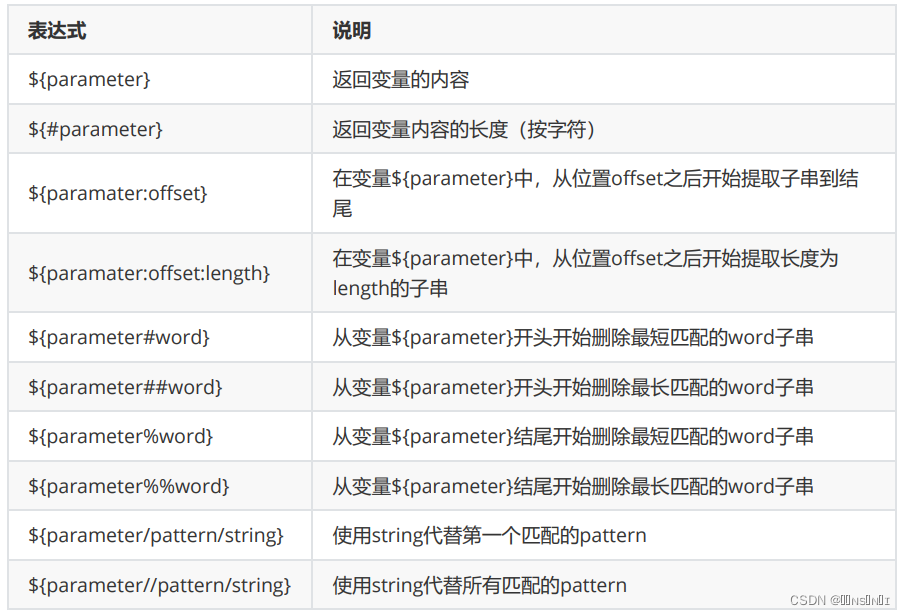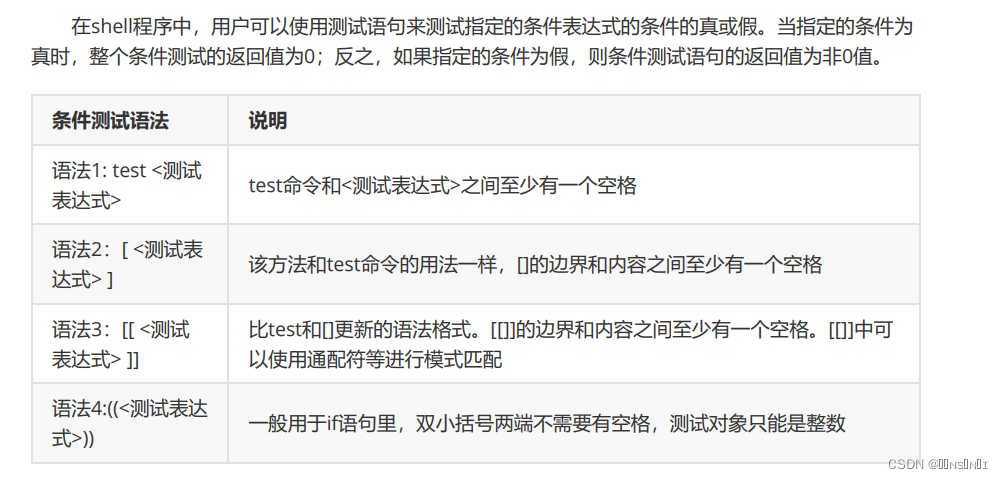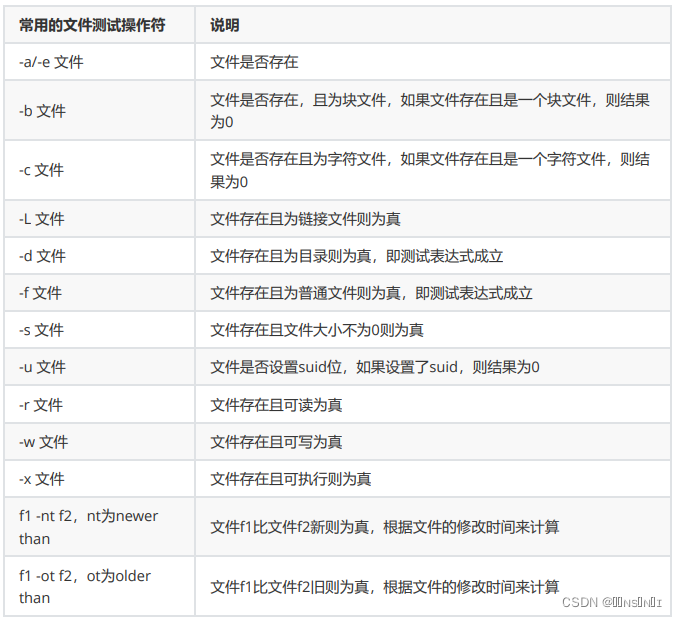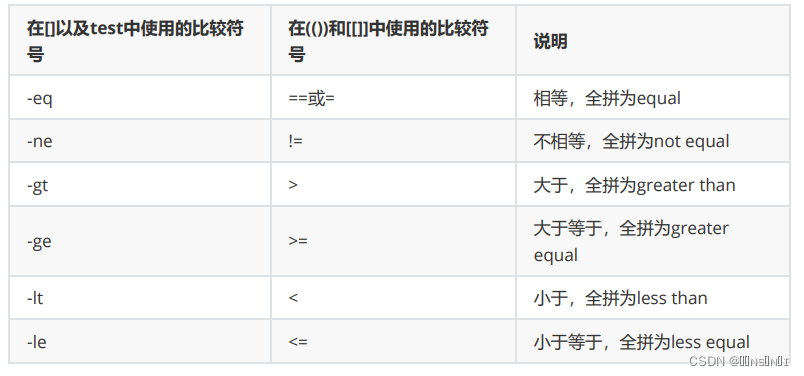shell的运算符
1、算术运算符:+,-,*,/,%,**
2、赋值运算符:=,+=,-=,/=,*=,%=
3、比较运算符:>,>=,<,<=,!=,==
4、逻辑运算符:and or not
5、位运算符:&,|,~,^,<<,>>
6、成员运算符:xxx in xxx
7、身份运算符:xxx is xxx
关于位运算
如下的三个概念,全部都是因为负数二进制运算出错,为了解决这个问题而诞生
原码:原始的二进制码
反码:符号位不变,其余各位取反
补码:反码加1 (计算机中将负数以补码形式存储)
在一个字节中
10 0000 1010
11 0000 1011
与运算符(一种为假则为假)
10 & 11 = 10
1010
1011 &
----------
1010
或运算符 (一种为真则为真)
10 | 11 = 11
1010
1011 |
----------
1011
异或运算符 (相反为真)
规律:
1、两个相同的数做异或结果为0
2、任何数和0异或,结果不会发生变化
10 ^ 11 = 1
1010
1011 ^
----------
0001
按位取反 (把真变假 把假变真)
~10
~0000 1010
-----------
1111 0101
左移运算
2 << 2 = 8
0000 0010 <<
-----------
0001 0000
右移动运算
>>
符号位: 0为正
1为负
0111 1111 +127
1111 1111 -127
1000 0000 -128一些使用运算符的例子
1 #!/bin/bash
2 #########################
3 #File name:test.sh
4 #Version:v1.0
5 #Email:admin@test.com
6 #Created time:2022-08-18 06:56:11
7 #Description:
8 #########################
9 a=$1
10 b=$2
11 echo a+b=$(($a+$b))
12 echo a-b=$(($a-$b))
13 echo a*b=$(($a*$b))
14 echo a/b=$(($a/$b))
15 echo a%b=$(($a%$b))
16 echo "--------------"
17 let r=$a+$b
18 echo a+b=$r
19 x=`expr $a + $b`
20 echo a+b=$x
[root@r8 shell_ex]# bash test.sh 8 4
a+b=12
a-b=4
a*b=32
a/b=2
a%b=0
--------------
a+b=12
a+b=12
${}中的使用

示例:截取字符串
[root@r8 shell_ex]# str1="hello world"
#返回变量长度
[root@r8 shell_ex]# echo ${#str1}
11
#变量截取
#指定起始位置,一直到结束
[root@r8 shell_ex]# echo ${str1:1}
ello world
#指定长度,不指定起始位置默认从开头开始
[root@r8 shell_ex]# echo ${str1::3}
hel
#指定起始位置和长度
[root@r8 shell_ex]# echo ${str1:1:3}
ell
#从右边第几个字符开始,及字符的个数
[root@r8 shell_ex]# echo ${str1:0-1:1}
d
#输出右边的几个字符
[root@r8 shell_ex]# echo ${str1:0-5}
world
[root@r8 shell_ex]# echo ${str1: -5}
world
#提取完整字符串
[root@r8 shell_ex]# echo ${str1:-5}
hello world示例:删除字符串
#获取后缀名tar.gz
[root@r8 shell_ex]# filename=testfile.tar.gz
[root@r8 shell_ex]# file=${filename#*.}
[root@r8 shell_ex]# echo $file
tar.gz
#获取后缀名.gz
[root@r8 shell_ex]# filename=testfile.tar.gz
[root@r8 shell_ex]# file=${filename##*.}
[root@r8 shell_ex]# echo $file
gz
#截取testfile.tar
[root@r8 shell_ex]# filename=testfile.tar.gz
[root@r8 shell_ex]# file=${filename%.*}
[root@r8 shell_ex]# echo $file
testfile.tar
#截取testfile
[root@r8 shell_ex]# filename=testfile.tar.gz
[root@r8 shell_ex]# file=${filename%%.*}
[root@r8 shell_ex]# echo $file
testfile条件测试的语法

文件测试表达式
测试文件的读、写、执行等属性,不光是根据文件属性rwx的标识来判断,还要看当前执行测试的用户 是否真的可以按照对应的权限操作文件。

示例:
让用户输入一个文件名,并做如下判断:
(1)如果用户输入的文件为空时显示:you must input a filename,并中断程序;
(2)如果用户输入的文件不存在时,显示the file do not exist,并中断程序;
(3)如果文件存在,判断该文件的文件类型和执行者对该文件所拥有的的权限。
1 #!/bin/bash
2 #########################
3 #File name:test.sh
4 #Version:v1.0
5 #Email:admin@test.com
6 #Created time:2022-08-18 06:56:11
7 #Description:
8 #########################
9 read -p "pleaes input a filename:" filename
10 [[ -z $filename ]] && echo "you must input a filename" && exit 0
11 [[ ! -e $filename ]] && echo "the file $filename do not exist" && exit 0
12 [ -f $filename ] && filetype="regulare file"
13 test -d $filename && filetype="directory"
14 test -r $filename && perm="readable"
15 test -w $filename && perm="$perm writable"
16 test -x $filename && perm="$perm executable"
17 echo "-----------------------------------------"
18 echo "the $filename is a $filetype"
19 echo "and the permissons are: $perm"
[root@r8 shell_ex]# bash test.sh
pleaes input a filename:test1
-----------------------------------------
the test1 is a regulare file
and the permissons are: readable writable
[root@r8 shell_ex]# bash test.sh
pleaes input a filename:unexit
the file unexit do not exist
常用字符串测试表达式

整数测试表达式

通过read读入两个整数,并比较他们的大小
1 #!/bin/bash
2 #########################
3 #File name:test.sh
4 #Version:v1.0
5 #Email:admin@test.com
6 #Created time:2022-08-18 06:56:11
7 #Description:
8 #########################
9 read -p "please input INTEGER:" num1 num2
10 test -z "$num1" && echo " error " && exit 0
11 [[ -z "$num1" ]] && echo " error " && exit 0
12 test "$num1" -eq "$num2" && echo "num1=num2"
13 [ "$num1" -gt "$num2" ] && echo "num1>num2"
14 [ "$num1" -lt "$num2" ] && echo "num1<num2"
15
测试
[root@r8 shell_ex]# bash test.sh
please input INTEGER:2 3
num1<num2
[root@r8 shell_ex]# bash test.sh
please input INTEGER:3 2
num1>num2
[root@r8 shell_ex]# bash test.sh
please input INTEGER:3 3
num1=num2
[root@r8 shell_ex]# bash test.sh
please input INTEGER:
error
假设执行一个可以携带参数的script,执行该脚本后屏幕会显示如下的数据:
程序的文件名;
共有几个参数;
若参数的个数小于2个则告知用户参数数量太少;
全部的参数内容;
第一 个参数;
第二个参数。
[root@r8 shell_ex]# vim one.sh
1 #!/bin/bash
2 #########################
3 #File name:one.sh
4 #Version:v1.0
5 #Email:admin@test.com
6 #Created time:2022-08-18 09:21:09
7 #Description:
8 #########################
9 [ "$#" != 0 ] && {
10 echo "the script name is $0"
11 echo "the parameter number is $#"
12 }
13
14 if [ "$#" -lt 2 ];then
15 echo "the number of parameter is less than 2."
16 exit 0
17 fi
18
19 if [ "$#" -gt 2 ];then
20 echo "your whole parameter is '$@'"
21 echo "the 1st parameter is $1"
22 echo "the 2nd parameter is $2"
23 fi
测试
[root@r8 shell_ex]# bash one.sh haha xixi hehe
the script name is one.sh
the parameter number is 3
your whole parameter is 'haha xixi hehe'
the 1st parameter is haha
the 2nd parameter is xixi
[root@r8 shell_ex]# bash one.sh haha xixi
the script name is one.sh
the parameter number is 2
本文含有隐藏内容,请 开通VIP 后查看